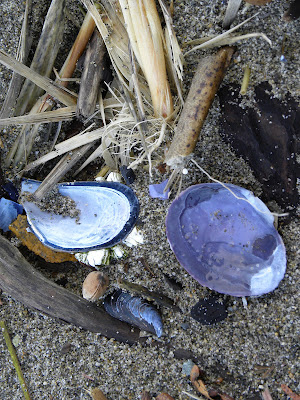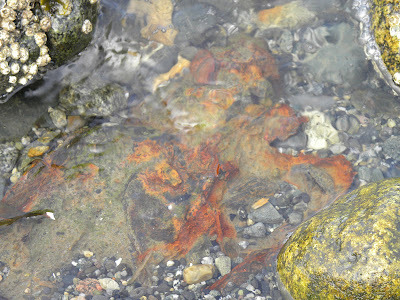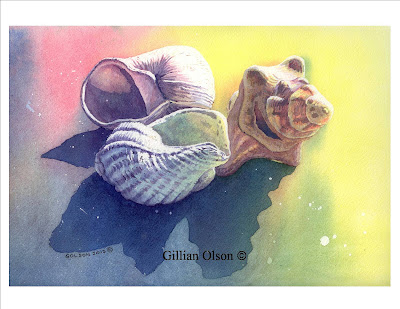You no doubt know the old rhyme "She sells sea shells sitting by the seashore", a tongue twister. There is something about a shell gathering adventure along the shore that brings back pleasant childhood memories: summer camping trips by the seashore with days spent on the sandy shore and evenings around the campfire smelling of salt and smoke.
Shells have been used as "money" or a medium of exchange, as tools (because of their strength and useful shapes), as a source of calcium carbonate and calcium for gardens, and as musical instruments. Shells also have many uses as decorations and adornments, as charms, in crafts and in art such as the Birth of Venus (Botticelli).
Also along the shore is a diverse selection of seaweed, algae and kelp.


Introduced products such as worn fragments of glass, creamics and metals (nails and pipes and discarded metal containers) also add colour and sometimes controversy.
And of course the rocks, pebbles and sand on the beach are colourful because they have been wet by the ocean and the colours enhanced by many small fragments of shell.

A worn dranage pipe adds interesting colour and shapes.
Here are a few bits of driftwood that excaped from the driftwood post a couple of weeks ago:
So to end here are the rest of the words to that old tongue twister:
This has been another scheduled post, I hope you have enjoyed this walk along the shore.
Thank you for dropping by, and happy Whimsy Wednesday, until next week .....
"A seashell or sea shell, also known simply as a shell, is a hard, protective outer layer created by an animal that lives in the sea. The shell is part of the body of the animal. Empty seashells are often found washed up on beaches by beachcombers. The shells are empty because the animal has died and the soft parts have been eaten by another animal or have rotted out.
The term seashell usually refers to the exoskeleton of an invertebrate (an animal without a backbone). Most shells that are found on beaches are the shells of marine mollusks, partly because many of these shells endure better than other seashells.
Apart from mollusk shells, other shells that can be found on beaches are those of barnacles, horseshoe crabs and brachiopods. Marine annelid worms in the family Serpulidae create shells made of calcareous tubes cemented onto other surfaces. The shells of sea urchins are called tests, and the moulted shells of crabs and lobsters are called exuviae. While most seashells are external, some cephalopods have internal shells." (Wikipedia)
Also along the shore is a diverse selection of seaweed, algae and kelp.


Introduced products such as worn fragments of glass, creamics and metals (nails and pipes and discarded metal containers) also add colour and sometimes controversy.
And of course the rocks, pebbles and sand on the beach are colourful because they have been wet by the ocean and the colours enhanced by many small fragments of shell.

Here are a few bits of driftwood that excaped from the driftwood post a couple of weeks ago:
So to end here are the rest of the words to that old tongue twister:
"She sells sea-shells on the sea-shore.
The shells she sells are sea-shells, I'm sure.
For if she sells sea-shells on the sea-shore
Then I'm sure she sells sea-shore shells."
Here is a recently finished painting of sea shells, called "What goes around..". It is a watercolour.
This has been another scheduled post, I hope you have enjoyed this walk along the shore.
Thank you for dropping by, and happy Whimsy Wednesday, until next week .....































